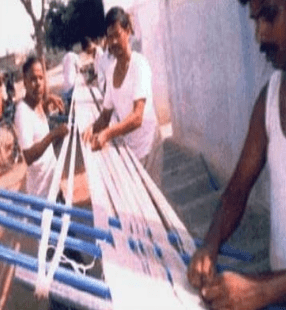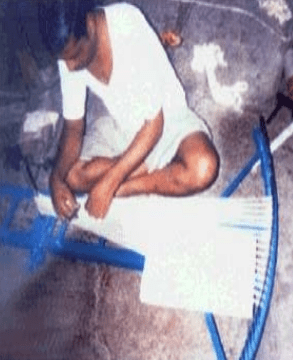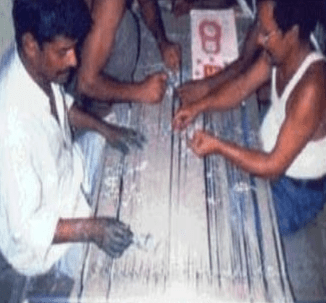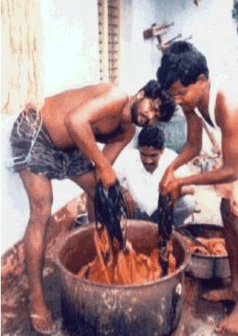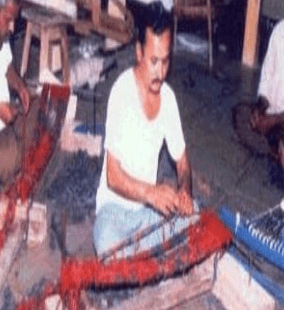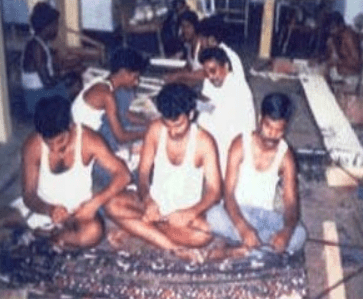It is widely believed that Ikat weaving in Andhra Pradesh developed around the turn of the century, if not earlier. No written document is available to ascertain the exact origin of the Ikat technique in this region. The Telugu word for tie and dye is chitki, which either comes from the word chit for dot or the common Telugu word chitti for small or tiny (the early chitki patterns were largely small dash-like forms). The oldest center, Chirala (in today’s Prakasam district), was once known to produce the famous cotton teliarumals, a square shaped loincloth woven in pairs measuring 55 to 75 square centimeters.
History
The Ikat technique of weaving has been in the Nalgonda district for the last 35-40 years. The origin of this technique is not very clear, but it appears to have been learnt and was not indigenous to the region. According to one version, weavers from Chirala who migrated to Nalgonda brought this technique of tie and dye with them. Another view holds that the nizam (title of the ruler of Hyderabad) settled a few weavers of Mashroo (brocaded cloth, with cotton inside and silk outside) here and that the Ikat technique developed out of that. Old weavers in the region remember that experts from HYCO, Weavers’ Service Centre and Pochampalli had come to train them in Ikat weaving decades ago. Ikats received a fillip in the 1960s, when the Government began encouraging the export of such fabric. The Festivals of India in the 1980s are also said to have fueled export interest in Ikats. This gave Ikats a clear-cut niche in markets, including export markets. Some say that local weavers went to Chirala to learn the technique, but found it difficult to execute the double Ikat weaving. So the weavers in Pochampalli started only with warp Ikat and only much later worked on double Ikat. The success of such Ikat saris in cottons led to experiments in silk as well. Silk Ikat saris from Pochampalli thus became a generic name for Andhra Ikats. In the last two decades, production of double and single Ikat fabric meant for dress materials and furnishings have proliferated throughout Nalgonda.
Regions
Today, Ikat weaving is spread over several weaving villages in the Nalgonda district of Andhra Pradesh. There are at least 40 villages within the 70-kilometer radius of Hyderabad where Ikat textiles are woven. Ikat production in Andhra Pradesh has also undergone specialization, with each village catering to definite market segments. Thus, Pochampalli specializes in silk saris of both single and double Ikat for the urban and semi-urban market. Choutuppal makes only cotton saris. Siripuram, Velanki and Koyyalagudem produce cotton and silk yardage as well as furnishings, both for domestic and export markets. There are a number of other weaving villages in the district producing Ikat fabric in different designs, textures and colors. Some of them are: Koyyalagudem, Bogaram and Siripuram (cotton centers), Choutuppal (mainly mercerized cotton), Puttapaka, Pochampalli, Ghattupal and Vellanki (which do both cotton and silk weaving, with Ikat saris being famous). Typically, these areas produce silk saris, cotton saris, shirting materials, furnishings, bed sheets and so on. Most of these also have co-operative societies, with a number of active weavers ranging from 200 to 450. An equal number is outside this structure, weaving mainly for the master weaver.
Producer Communities
The Padmasali and Devangula communities are engaged in Ikat weaving in this region.
Availability of Raw Material in Andhra Pradesh
Yarn is bought from nearby Secunderabad (about 40 kilometers away), Vijayawada and Chirala. Aadoni and Dwarapudi are also accessed for yarn while silkyarn is from Nagari and Dharmavaram.
Tools Used
Charka
This is used for winding the yarn on the bobbin (warp) and pirn (weft).
Warping Machine
The warp yarn is prepared on a warping machine (known in telugu as aasu).
Chitiki Frame
This is used in order to obtain weft designs. Yarn is tied on the frame and then designs are marked.
Loom or Slay
The bobbin is fit in to the shuttle and this shuttle is put on the loom for weaving. This is called interlacement of weft and warp to form a fabric.
Dobby and Jacquard
For weaving of extra warp designs they use the dobby for small designs and jacquard for bigger designs.
Different Ikat Making Techniques/Varieties
Single Ikat
Single Ikat Warp Design
Single Ikat Weft Design
Single Ikat for Combined
Double Ikat
Production Process/ Ikat Technique
The Ikat technique allows the weaver to prepare precisely the exact pattern of colors on the finished fabric by wrapping sections of the yarn with rubber strips before dipping it in select dyes. The rubber strips used for tying are a modern innovation replacing the traditional method of tying with coarse cotton thread.
The use of resist or barrier to protect certain portions of the yarn or cloth from the dye is a way of enabling several colors to be used on the same textile. There are several resist techniques, such as tie and dye and wax resist batik. But in the Ikat technique, the resist is applied not to the woven fabric, but to the yarn before it is woven. This process involves careful sorting of threads before and after dyeing, and meticulous arrangement of warp and weft threads, so that the pre-dyed sections appear at the right place in the design.
The basic steps in processing are:
•Warp and weft threads are divided into bundles or sets.
•The yarn is then tied with waterproof material, strips of leaf, rubber or plastic to correspond with the pre-arranged design plates.
•Then the tied bundles are dyed according to design. (This requires several stages of tying and dyeing, depending on the design).
•Resists are removed, aligned according to the pattern and put on the loom.
Ikat or yarn resist dyeing involves the sequence of tying (wrapping) and dyeing sections of bundled yarn to a pre-determined color scheme or pattern, prior to weaving. Thus, the dye penetrates into the exposed sections, while the tied sections remain un-dyed. The patterns achieved by the process on the yarn are then woven into fabric.
Within the three Ikat categories, single Ikat involves tying and dyeing of either warp or weft threads. In combined Ikat, both warp and weft Ikat coexist in different parts of the fabric, with both thread systems occasionally over lapping. In double Ikat, both warp and weft threads are tied and dyed in such a manner that when woven, threads from both axes mesh exactly at pre-determined points to form a motif or pattern. In Andhra Pradesh, Ikat fabric is produced on pit looms, and semi-circular frames are used in the preparation of warp and weft.
Yarn Preparation
The first stage is the buying of yarn (cotton or silk as the case maybe). This is done by the co-operatives as well as master weavers, and given to weavers. The weaver and his family then begin the pre-loom process of boiling, charka winding, warping, dyeing, and piecing.
Then the dressing and weaving is done on the loom.
Skeins of yarn are wound individually on hand reels and then plied together in clusters. This is followed by the process of de-gumming and bleaching. Then the yarn is left to dry and then wound. Next it is wound once again on a twisting machine.
Grouping the Weft
This step entails preparation of yarn for resisting dye. The weft yarn is spread out horizontally from a reel on to a special frame, going to and fro between a bigger iron peg on one side and around smaller ones arranged in a semi-circle on the other side. The distance between the big and small pegs corresponds to the width of the finished fabric. This tool for grouping the weft is used typically in the Pochampalli area, and not anywhere else (such as in Chirala).
Wrapping the Weft
This is done on the bundles still stretched on the frame (see description above). Usually the dyeing is done from memory. Graphs and paper drawings are used only in very intricate or newly developed designs. The dyeing sequence is usually as follows: red is first dyed, followed by yellow or orange, followed by green or blue. Black is obtained by dyeing over red and blue with iron fillings. For dyeing, the skeins are taken off the frame, and after drying, replaced on the pegs in accurate order for the next unwrapping and wrapping steps. After dyeing, the yarn is thoroughly wrung and immersed in developing solution. Later it is washed in cold water and hung out to dry.
Preparation of the Warp
In the case of silk saris, the silk is bought as a warp in a length of seven saris.
After bleaching, the different sections of the warp are partly dyed, as the main body and end pieces of the sari are often in contrasting colors. The main body remains white, while the ends are dip-dyed in a green dye bath.
To make the threads more resistant, the yarn is dipped in a solution of water, rice starch and coconut oil. The warp is then stretched out to its full length on a long corridor. Weft threads are separated for weaving and, where necessary, put in order.
Preparation of Loom for Weaving
The loom is a traditional pit loom with two shafts, modernized with a fly shuttle. While weaving, each weft has to be carefully set in the right position in order to achieve a clear pattern. The time taken to weave a warp is usually four to five days.
Design and Markets
There is a sizeable market for Ikat products. Master weavers too have their local channels of buyers, either private retail showrooms or other direct buyers. In addition, both also have export markets. The contacts are established through the HHEC Handicrafts and Handlooms Export Corporation of India (HHEC) and fabric is exported to countries like Japan, Italy, Australia, Canada, etc.
The tastes of design and color combinations have also been changing very fast. In recent times, diversification of the product line from saris to yardage has changed the design vocabulary in the region. Yardage is mainly designed for urban and international customers. Buyers, especially in international markets, have become very specific with the forecasting of the colors and market conditions before giving orders. Several aspects like color fastness and the use of eco-friendly azo-free dyes play an important role especially in the export market, and natural dyes have also gained popularity.




